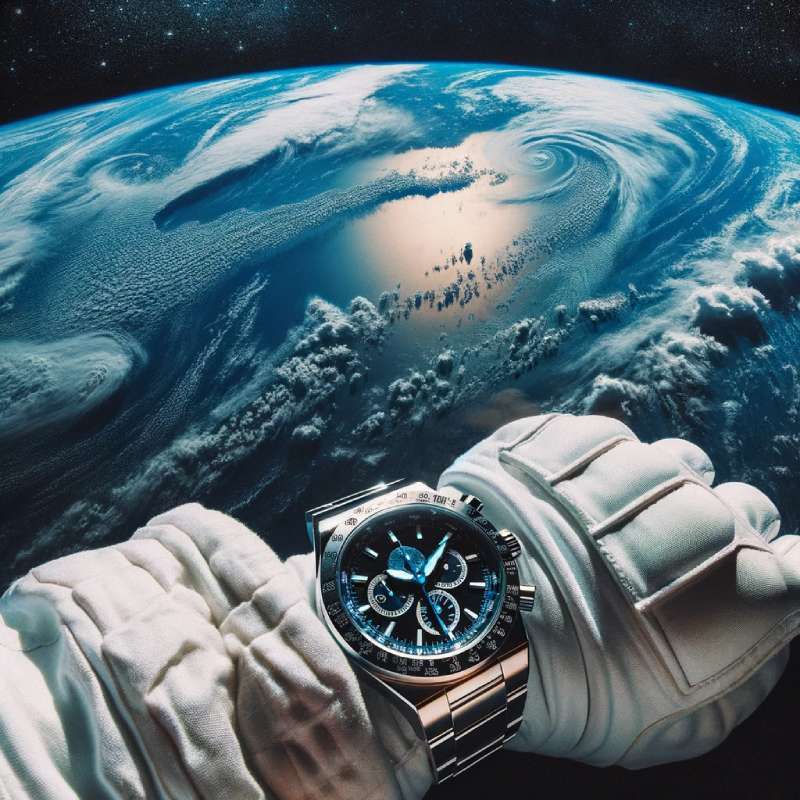The History of Timekeeping in Space
The Dawn of a New Era: Watches That Embarked on Cosmic Voyages
The story of timekeeping in space is as captivating as the history of space exploration. From the early days of manned spaceflights to the present, watches have played a pivotal role in the success of these missions, evolving from mere timekeepers to essential tools for survival and navigation in the void of space.
In the nascent stages of space travel, astronauts faced the daunting task of finding timepieces that could withstand the rigors of space. The initial space missions relied on the astronauts’ watches, selected for their reliability but not specifically engineered for space. These early timekeeping devices were crucial for basic timing tasks but were soon to be eclipsed by more advanced requirements of evolving space missions.
The progression of space travel necessitated the development of official space watches. These were not just timepieces but tools of survival, ensuring the accuracy and reliability needed for precise maneuvers and experiments in space. Collaborations between space agencies and esteemed watchmakers marked a new era in space horology, giving rise to watches that could endure zero gravity, extreme temperature fluctuations, and intense radiation.
The shift from mechanical to quartz watches in space mirrored the broader technological advancements of the time. Quartz watches offered superior accuracy and lower maintenance – both crucial for long-duration space missions. The advent of digital watches introduced new functionalities, such as alarms and countdown timers, essential for the timing precision required in complex space operations.
Significant milestones in space horology include historic firsts, like the first watch on the moon, and the pioneering timepieces used in groundbreaking spacewalks. These watches didn’t just keep time; they made history. A retrospective of notable space missions and the watches that accompanied them provides insight into the critical role these timepieces played in the annals of space exploration. From the Omega Speedmaster’s journey to the moon aboard Apollo 11 to the Seiko worn during the first spacewalk, each watch tells a story of human endeavor and the relentless pursuit of precision in the cosmos.
In this exploration of timekeeping in space, we uncover a saga of innovation and resilience, where watches have stood as silent yet crucial companions to astronauts, helping them navigate the complexities of space travel with precision and reliability.
Iconic Space Watches and Their Missions
Timepieces That Defied Gravity and Witnessed the Stars
In the realm of space exploration, certain watches have not only been functional tools but have also etched their names in history. This section highlights some of the most iconic timepieces that have been part of legendary space missions, revealing the stories behind their selection and the extraordinary feats they achieved beyond Earth’s atmosphere.
The Omega Speedmaster and the Apollo Missions:
- The Moonwatch Legacy: Perhaps the most legendary of all space watches is the Omega Speedmaster, famously known as the “Moonwatch.” Selected by NASA for the Apollo missions, it was the first watch worn on the moon during Apollo 11 in 1969. Its robust mechanical movement, legible design, and ability to withstand extreme conditions made it an ideal choice for space travel.
- A Symbol of Exploration: Beyond its technical achievements, the Speedmaster became a symbol of human exploration, representing the daring spirit of the astronauts who ventured into the unknown.
Seiko and the Spacewalk:
- Innovation in Zero Gravity: Seiko’s contributions to space horology are marked by its distinction as the first automatic watch used during a spacewalk. The Seiko 5 Sports Speed-Timer’s reliability and self-winding mechanism made it suitable for the demanding environment of space.
- A Moment in Orbit: Worn by Soviet cosmonaut Alexei Leonov, this Seiko watch proved its mettle when it functioned flawlessly in the vacuum of space, marking a significant achievement in watchmaking history.
Rolex GMT Master in Skylab:
- Precision Amidst Experimentation: The Rolex GMT Master, known for its dual time zone feature, was chosen for the Skylab missions. It played a crucial role in helping astronauts keep track of multiple time zones, a necessity in the orbiting laboratory’s experiments and communication with Earth.
- Enduring the Extremes: The watch’s resilience in the face of Skylab’s extreme conditions further cemented Rolex’s reputation for creating timepieces of unparalleled toughness and reliability.
These watches are more than mere instruments of time; they are enduring reminders of humanity’s quest to reach beyond our planet. Their stories intertwine with those of the astronauts who wore them, offering a glimpse into the challenges and triumphs of space exploration. As we continue to push the boundaries of what is possible, these timepieces stand as a testament to the enduring partnership between horology and the final frontier.
Technical Features of Space Watches
Engineering for the Cosmos: The Unique Attributes of Space Timepieces
Space watches are more than just timekeepers; they are marvels of engineering, tailored to withstand the extreme conditions of space. This section examines the specific design elements and technical features that equip these watches for their celestial journeys, underscoring the ingenuity and precision that go into crafting timepieces for the final frontier.
1. Design and Durability:
- Robust Construction: Space watches are built to endure the harsh environment of space, including extreme temperature fluctuations, vacuum conditions, and intense vibrations during launch and re-entry.
- Materials and Craftsmanship: The use of specialized materials like titanium, advanced ceramics, and sapphire crystal is common in space watches. These materials offer the necessary strength, scratch resistance, and lightness required for space travel.
2. Unique Functionalities:
- Precision Timekeeping: Given the critical nature of timing in space missions, these watches boast highly precise movements, whether mechanical or quartz, ensuring accuracy in time measurement.
- Specialized Features: Depending on the mission requirements, space watches may include features such as chronographs, countdown timers, tachymeters, and GMT functions to track multiple time zones.
3. Adaptations for Space Conditions:
- Anti-Reflective Coatings: To ensure legibility in the unfiltered sunlight of space, watch crystals often feature anti-reflective coatings.
- Temperature Resistance: Space watches are designed to function reliably in the extreme temperatures of space, from the intense cold of the dark side to the searing heat of direct solar exposure.
4. Ergonomic Considerations:
- Ease of Use in Zero Gravity: The design of space watches takes into account the ease of use in a zero-gravity environment, with features like larger buttons and dials that can be operated while wearing space gloves.
- Strap and Bracelet Design: Straps and bracelets are made adjustable to fit over the bulk of a spacesuit or comfortably on the wrist in a weightless environment.
These technical features not only make space watches an essential tool for astronauts but also exemplify the pinnacle of watchmaking innovation. They embody a perfect blend of functionality, durability, and precision, crafted to perform in the most challenging conditions known to humankind.
Watches in Recent and Future Space Missions

The New Frontier: Timekeeping Innovations for Modern Space Exploration
As space exploration enters a new era with private companies and international collaborations venturing beyond Earth’s orbit, the role of timekeeping continues to evolve. This section explores the watches used in recent space missions, their cutting-edge features, and speculates on future trends in space horology, highlighting how they are adapting to the changing landscape of space travel.
1. Modern Space Watches:
- Private Space Ventures: With the advent of private space companies like SpaceX, new models of watches are being tested and used in missions, reflecting the latest in horological technology and design.
- International Space Missions: Recent international missions have seen a diverse array of watches, chosen for their precision and durability to support the complex demands of modern space travel.
2. Advanced Features and Technologies:
- Smartwatch Integration: The integration of smartwatch technology in space missions offers advanced features like health monitoring, mission timers, and real-time communication capabilities.
- Enhanced Durability and Functionality: Newer space watches incorporate advanced materials and designs for enhanced durability, such as improved resistance to radiation and more robust mechanical movements.
3. Future Trends in Space Horology:
- Customization for Mission-Specific Needs: Future space watches may offer customization options to cater to specific mission requirements, such as specialized tracking features or environmental sensors.
- Evolving Design Aesthetics: As space travel becomes more common, the aesthetics of space watches may evolve to reflect a broader appeal, merging traditional design with futuristic elements.
4. The Role of Watches in Interplanetary Travel:
- Mars Missions and Beyond: As humanity sets its sights on Mars and other celestial bodies, watches will need to adapt to different planetary environments, possibly incorporating features for different timekeeping systems and extraterrestrial conditions.
- Innovation in Timekeeping: The unique challenges of interplanetary travel will drive innovation in watchmaking, pushing the boundaries of what is currently possible in timekeeping technology.

